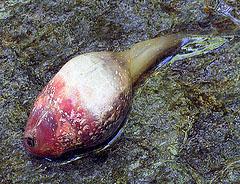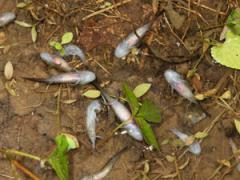Amphibian Disease
Emerging diseases are threatening amphibian populations worldwide and impacting native species in New Jersey.
CHYTRIDIOMYCOSIS
Chytridiomycosis is the disease caused by the chytrid fungus Bd (Batrachochytrium dendrobatidis). First identified in 1998 on dead frogs in South America, Bd feeds on the protein keratin which is found in the skin of adults and the mouths or jaw sheaths of tadpoles. As the fungus feeds and reproduces, it breaks down the host amphibian's skin, preventing proper water absorption and leading to desiccation, decreased respiration, damage to the nervous system, behavioral changes, and eventually death. Believed to be the main factor in the current wave of amphibian declines, Bd has been found on every continent except Antarctica. Although most mass mortalities attributed to chytridiomycosis have occurred in Central and South America, temperate zones like the western United States and northern Australia have also been devastated.
 Zoom+ Frog infected by chytridiomycosis
Zoom+ Frog infected by chytridiomycosis
Currently no Bd-related mortalities have been found in New Jersey's amphibians but the fungus is present. In 2010, CWF partnered with ENSP and Montclair State Universityto perform a state-wide survey to screen for chytridiomycosis. Through surveying a wide-variety of water bodies and a broad sampling of NJ’s amphibians, including the state endangered eastern tiger salamander and state threatened Pine Barrens treefrog, we hope to learn what species and ecosystems are at highest risk in New Jerseyand hopefully what can be done to prevent mortalities. Preliminary analyses suggest Bd presence in New Jersey is low. This effort was documented in the Philadelphia Inquirer in 2011.
In 2013, the fungus, Batrachochytrium salamandrivorans, or Bsal, which is similar to Bd but primarily found in salamanders rather than in frogs, emerged in Europe and has begun to cause massive declines in several salamander species. Thought to originate in Asia, Bsal has not yet been found in North America, which has the greatest salamander diversity in the world. To protect this important species diversity, the United States Fish and Wildlife Service has banned the trade of over 200 species of salamanders from other countries to reduce the risk of infection in native populations.
RANAVIRUS
Over the past few decades, ranaviruses have been implicated in mass die-offs of amphibians, reptiles, and fish in both captive and wild environments. Ranavirus has been reported on almost every continent in a wide-range of environments, with die-offs frequently involving multiple species. In the United States, ranavirus has been found in more than 25 states, affecting over 20 species of amphibians and 2 species of turtles. In the US, amphibian mortality linked to these ranavirus events are significantly greater and more widespread than those associated with chytridiomycosis.
 Zoom+ Skin hemorrhaging in tadpole © David Stang
Zoom+ Skin hemorrhaging in tadpole © David Stang
Ranaviruses comprise a group of viruses in the family Iridoviridae. In amphibians these viruses can cause 90% juvenile mortality in breeding pools, with hundreds to thousands of deaths within a 1 to 5 day period. The virus causes subtle to severe skin hemorrhaging (bleeding), especially at the base of hind legs and vent (cloaca), fluid accumulation under the skin, lethargy, erratic swimming, and frequently death. Amphibians are most susceptible to ranavirus before and during metamorphosis when their immune systems are at their lowest.
In New Jersey, ranavirus can affect larval mole salamanders, true frogs, chorus frogs, red-spotted newts, and treefrogs. Die-off events involve early vernal-pool breeding amphibians, such as wood frogs, and occur in the late spring during metamorphosis. Die-off events later in the season will affect green frogs and bullfrogs as metamorphosis occurs towards the end of summer. Ranavirus has also been documented in the state threatened wood turtle and state special concern box turtle.
 Zoom+ Dead larval marbled salamanders during a multi-species ranavirus outbreaks © Matt Niemiller
Zoom+ Dead larval marbled salamanders during a multi-species ranavirus outbreaks © Matt Niemiller
Unfortunately, persistence of ranavirus in the environment is poorly understood but the virus is believed to be fairly common as infection occurs simultaneously in multiple species. Adults of some species are able to survive with low-level infections and become reservoirs, or carriers, for the disease, introducing the virus into new populations or breeding pools. Since ranavirus is spread through contact, species like wood frogs that aggregate as larvae are more prone to spreading infection.
CWF worked with NJ Division of Fish and Wildlife as part of a Regional Conservation Need grant led by Maryland Department of Natural Resources to test wood frog breeding pools across MD, VA, DE, PA, and NJ for ranavirus. Among other results of the study, it was found that ranaviruses were present in previously unknown locations throughout the region, and the disease persisted at certain sites between each year of the study. This information is being used to understand the impact ranaviruses are having on amphibians and reptiles across our region.




